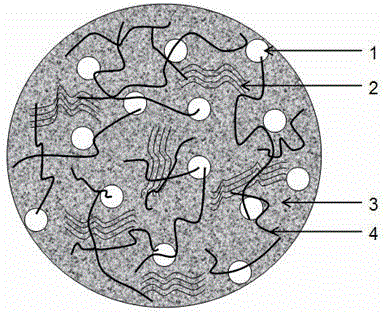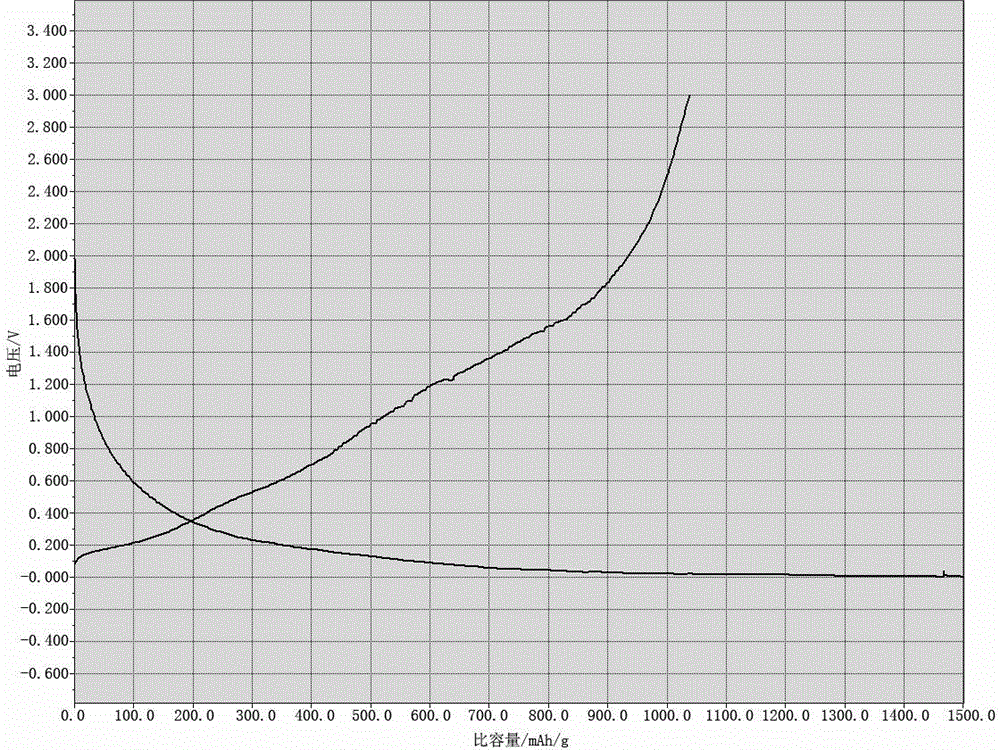Multi-component composite anode material and preparation method thereof
A negative electrode material and multi-component composite technology, which is applied in the field of multi-component composite negative electrode materials and their preparation, to achieve the effect of excellent electrochemical characteristics
- Summary
- Abstract
- Description
- Claims
- Application Information
AI Technical Summary
Problems solved by technology
Method used
Image
Examples
Embodiment 1
[0017] like figure 1 Dissolve polyvinyl alcohol with a degree of polymerization of 170 in deionized water to form an organic PVA solution with a concentration of 0.08; then silicon powder with a particle size of 35nm (accounting for 21% of the total weight of the composite material), a pipe diameter of 40nm and an electrical conductivity Carbon nanotubes with a size of 119 s / cm (accounting for 5% of the total weight of the composite material) and expanded graphite with a size of 10 microns (accounting for 19% of the total weight of the composite material) were added to the above-mentioned organic solution, at 80 o Stir vigorously at C until all the water is volatilized to form a precursor powder; the precursor powder is placed in a tube furnace protected by argon for sintering, and the heating rate is 5 o C / min, the sintering time is 10h, and the sintering temperature is 650 o C, after cooling at room temperature, a multi-component composite negative electrode material contai...
Embodiment 2
[0019] Dissolve polyvinyl alcohol with a degree of polymerization of 1900 in deionized water to form an organic PVA solution with a concentration of 0.2; then silicon powder with a particle size of 20nm (accounting for 30% of the total weight of the composite material), a pipe diameter of 50nm and an electrical conductivity Carbon nanotubes with a diameter of 200 s / cm (accounting for 7% of the total weight of the composite material) and expanded graphite with a size of 20 microns (accounting for 26% of the total weight of the composite material) were added to the above-mentioned organic solution respectively, at 90 o Stir vigorously at C until all the water is volatilized to form a precursor powder; the precursor powder is placed in a tube furnace with nitrogen protection for sintering, and the heating rate is 8 o C / min, the sintering time is 10h, and the sintering temperature is 750 o C, After cooling at room temperature, a multi-component composite negative electrode materia...
Embodiment 3
[0021] figure 2 As shown, polyethylene glycol with a molecular weight of 5000 was dissolved in deionized water to form an organic solution with a concentration of 0.4; then silicon powder with a particle size of 200nm (accounting for 28% of the total weight of the composite material) with a diameter of 45nm and an electrical conductivity Carbon nanotubes with a rate of 320 s / cm (accounting for 3% of the total weight of the composite material) and expanded graphite with a size of 0.5 microns (accounting for 30% of the total weight of the composite material) were added to the above organic solution respectively, at 80 o Stir vigorously at C until all the water is volatilized to form a precursor powder; the precursor powder is placed in a vacuum furnace for sintering, and the heating rate is 6 o C / min, the sintering time is 6h, and the sintering temperature is 700 o C, After cooling at room temperature, a multi-component composite negative electrode material containing 39% amor...
PUM
| Property | Measurement | Unit |
|---|---|---|
| diameter | aaaaa | aaaaa |
| pore size | aaaaa | aaaaa |
| size | aaaaa | aaaaa |
Abstract
Description
Claims
Application Information
 Login to View More
Login to View More - R&D
- Intellectual Property
- Life Sciences
- Materials
- Tech Scout
- Unparalleled Data Quality
- Higher Quality Content
- 60% Fewer Hallucinations
Browse by: Latest US Patents, China's latest patents, Technical Efficacy Thesaurus, Application Domain, Technology Topic, Popular Technical Reports.
© 2025 PatSnap. All rights reserved.Legal|Privacy policy|Modern Slavery Act Transparency Statement|Sitemap|About US| Contact US: help@patsnap.com


